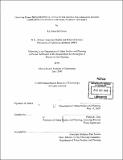Using the urban design process as a catalyst for ongoing collaboration between communities and schools : Northside, Paterson, New Jersey
Author(s)
Green, La Tonya M. (La Tonya Mellissa), 1975-
DownloadFull printable version (11.73Mb)
Other Contributors
Massachusetts Institute of Technology. Dept. of Urban Studies and Planning.
Advisor
Phillip L. Clay.
Terms of use
Metadata
Show full item recordAbstract
Inner city neighborhoods and schools are inextricably linked to each other. While this fact seems obvious and irrefutable, cooperation between urban schools and the neighborhoods they are in is often either non-existent or counterproductive. In planning for whole school reform, discussions of how the community could be improved are often ignored or deemed not to take priority. This thesis argues that the use of a communicative urban design process can be a successful community development tool. More specifically, a communicative urban design process can help forge collaborative, cooperative relationships between neighborhoods and schools. Notions of a communicative urban design process are linked with community development to analyze planning of a educational park that will be located between two schools in the Northside neighborhood of Paterson, New Jersey. By involving staff, faculty, parents, and students from the schools and residents from the Northside neighborhood in the design of the educational park, it became possible for the two groups to share their thoughts and concerns with each other. The communicative urban design process provided a space and cause for the wide set of constituents to participate. The process allowed for collaboration which was critical to the broadening of perspectives of the relationship of the school to the community and vice versa. Through participant-observation of the planning and design process, light is shed on the feasibility of using a communicative urban design process as a community development tool. Factors in the design process that enable better collaboration and cooperation between the schools and community are identified, and recommendations are made to address shortcomings in the design process.
Description
Thesis (M.C.P.)--Massachusetts Institute of Technology, Dept. of Urban Studies and Planning, 2000. Includes bibliographical references (leaves 93-95).
Date issued
2000Department
Massachusetts Institute of Technology. Department of Urban Studies and PlanningPublisher
Massachusetts Institute of Technology
Keywords
Urban Studies and Planning.